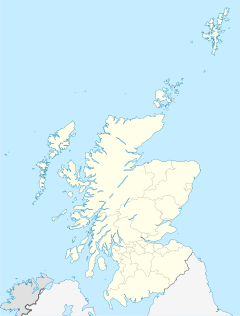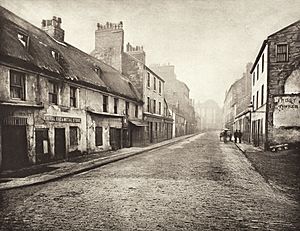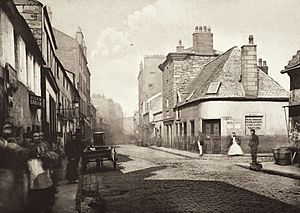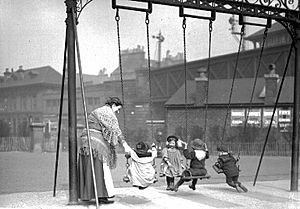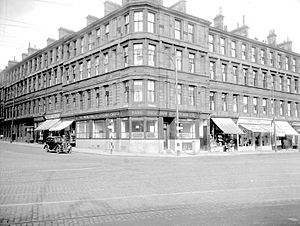Gorbals facts for kids
Quick facts for kids Gorbals
|
|
|---|---|
| Area | 0.83 km2 (0.32 sq mi) |
| Population | 6,030 (2015) |
| • Density | 7,265/km2 (18,820/sq mi) |
| OS grid reference | NS 59100 64000 |
| Council area | |
| Lieutenancy area |
|
| Country | Scotland |
| Sovereign state | United Kingdom |
| Post town | GLASGOW |
| Postcode district | G5 |
| Dialling code | 0141 |
| Ambulance | Scottish |
| EU Parliament | Scotland |
| UK Parliament |
|
| Scottish Parliament |
|
The Gorbals is an area in the city of Glasgow, Scotland. It sits on the south side of the River Clyde. It used to be a separate town, or burgh.
In the late 1800s, many people moved to Gorbals. They came from the countryside and other countries. They were looking for jobs in Glasgow's new factories. At its busiest in the 1930s, the Gorbals area had about 90,000 people. This made it very crowded.
After World War II, the area was rebuilt. Today, fewer people live there. Many tall apartment buildings, called high-rises, were built. Most of these have now been taken down. Only six are still standing in 2023.
Contents
What Does "Gorbals" Mean?
The name "Gorbals" first appeared in old records in the 1400s and 1500s. Its exact meaning is not fully clear.
One idea is that it comes from an old word meaning "sheaf." A sheaf is a bundle of cut grain. This might refer to a special payment of grain given to a church leader.
Another idea links it to a Scots word for a "young bird." This could be a reference to people with leprosy who were allowed to ask for help in public. Some people also think the name means "garden of the town."
Gorbals' Early Days
The village of Gorbals was once known as Bridgend. This was because it was at the south end of a bridge over the Clyde River. It was a quiet, farming area at first. There was some early trading and mining too.
The Industrial Revolution brought big changes to Glasgow. New inventions, like those by James Watt, helped the city grow fast. In 1846, Glasgow took over Gorbals. At that time, Gorbals had about 3,000 people. It had factories for spinning cotton and weaving cloth. There were also ironworks and engineering businesses.
During the 1800s and 1900s, many people moved to Gorbals. They came from the Scottish Highlands and Ireland. Immigrants also arrived from Italy and Eastern Europe. They all came to work in Glasgow's growing industries.
History of Gorbals
The land where Gorbals stands was once owned by the church. In 1345, a bridge was built over the River Clyde. This bridge gave the village its old name, Brigend. It lasted until the 1800s.
Around 1350, a hospital for people with leprosy was built here. It was named after St Ninian. The land around it was called St Ninian's Croft. This area later became part of Hutchesontown.
Changes in Land Ownership
After the Protestant Reformation in 1579, the church gave the land to Sir George Elphinstone. He was a merchant and a leader in Glasgow. In 1606, King James VI confirmed that Elphinstone and his family owned the Gorbals.
Later, in 1650, the land was given to Glasgow's leaders. It was for the benefit of the city, the Trades' House, and Hutchesons' Hospital. These groups then collected rents from the land. They divided the money among themselves.
In 1790, the land was divided into smaller parts for building. The city got some old parts of Gorbals and Bridgend. The Trades' House got a western section. Hutchesons' Hospital received the eastern and southern parts.
One builder, James Laurie, built the first house on St Ninian Street in 1794. You can still see the gravestones of Laurie and other builders at the Gorbals Rose Garden. This was once a burial ground started in 1715.
Growth and Challenges
Today, the areas are known as Gorbals, Laurieston, Tradeston, Kingston, and Hutchesontown. The small village of Little Govan was replaced by parts of Hutchesontown and Oatlands.
In the late 1800s, Gorbals became a busy industrial area. Many people moved there from Ireland, Italy, and Eastern Europe. At one time, most Jewish people in Scotland lived in this area.
However, as industries declined and more people moved in, the area became very poor in the early 1900s. A railway station, Gorbals railway station, opened in 1877. But it closed to passengers in 1928 because there was less business.
In the 1870s, the city cleared away the old Gorbals village. They rebuilt the area to create the new Gorbals Cross. They also built new apartment buildings for workers.
Much of the old Gorbals village was replaced by modern apartment blocks. These were built in a grid pattern, like in the city center. The beautiful classical buildings of Laurieston were also built along the river.
By 1914, people in Gorbals and Hutchesontown worked in many local industries. These included carpet making, clothing, food, ironworks, and engineering. The area had many schools, churches, synagogues, and theaters. One theater, the Royal Princess's, is now the Citizens Theatre.
However, nearly half of the 19,000 houses were too crowded. To fix this, new public housing began in the 1920s. Between 1921 and 1951, the population of Gorbals and Hutchesontown dropped by 21%. By 1964, there were 12,200 houses.
Modern Redevelopment
After World War II, in the 1950s, Glasgow decided to tear down many old inner-city areas, including Gorbals. Families were moved to new housing estates outside the city. Some were rehoused in huge concrete multi-story towers within the Gorbals.
The nearby Govanhill district still looks a bit like the old Gorbals. Its residents saw the changes happening in Gorbals. They worked to prevent their own homes from being torn down.
The new high-rise towers built in the 1960s improved living conditions. But they also caused social problems. The buildings were not always well-designed or built. Many developed mold and structural issues. Their design made it hard for people to feel safe or connected to their neighbors.
The Queen Elizabeth Square flats, designed by Sir Basil Spence, were torn down in 1993. This made way for newer housing.
In 2004, plans were made to demolish more old high-rise blocks. Others were to be fixed up. Many high-rises were taken down between 2002 and 2016. In 2021, it was announced that two more multi-story blocks would be demolished. This means only one group of high-rise flats, called the "Riverside" estate, will remain in Gorbals.
New housing has been built with fewer homes per area. The new designs aim to make residents feel safer.
Much of the Gorbals, especially Hutchesontown, has been rebuilt for a third time. This time, there is a mix of private homes and social housing. Newer buildings have bold and modern designs. They also have good street plans and green spaces. Many pieces of public art have been added.
The Gorbals Leisure Centre opened in 2000. There are also more shops in the area. In 2005, a fire destroyed the Catholic Church of Blessed John Duns Scotus. It was rebuilt and reopened in 2010. The rebuilding and improvement programs have now moved to the neighboring Laurieston area.
In the early 2000s, a local group started a campaign to bring back the old cross fountain. They found a copy of the original fountain on the island of St Kitts & Nevis. They are working to create a new copy to be placed near its original spot.
The Citizens Theatre has been in the Gorbals since 1945. The area also has a local newspaper called Local News for Southsiders. You can reach Gorbals by subway at Bridge Street and West Street stations. Many bus routes also serve the area.
The Caledonia Road Church is a beautiful old building nearby. It was designed by Alexander "Greek" Thomson. Only its walls and tower remain.
Historical Maps
You can find many old maps of the Gorbals at the National Library of Scotland.
Notable People from Gorbals
Many famous people have lived in or come from the Gorbals:
- Frank Bruno (b. 1961), a famous boxer, moved to Gorbals in 2012.
- Lawrence Chaney (b. 1996), a drag queen who won a TV show.
- Paddy Connolly (b. 1970), a football player and coach.
- Owen Coyle (b. 1966), a football player and manager.
- Paddy Crerand (b. 1939), a football player for Celtic and Manchester United.
- Tommy Docherty (1928–2020), a football player and manager.
- Dame Carol Ann Duffy (b. 1955), a well-known poet.
- Hannah Frank (1908–2008), an artist and sculptor.
- Ralph Glasser (1916–2002), a writer who wrote about growing up in the Gorbals.
- Alex Harvey (1935–1982), a musician.
- Alexander Watson Hutton (1853–1936), a teacher who helped start football in Argentina.
- Lorraine Kelly (b. 1959), a popular television presenter.
- Helena Kennedy (b. 1950), a member of the House of Lords.
- John Kurila (1941–2018), a footballer.
- Sir Thomas Lipton (1848–1931), who founded Lipton's Tea.
- Benny Lynch (1913–1946), a boxer who became a World Champion.
- Gerry McAloon (1916 – 1987), a football player.
- Gerry McLauchlan (b. 1989), a former footballer.
- John Maclean (1879–1923), a socialist politician.
- Frank McLintock (b. 1939), a football player and TV expert.
- John Martyn (b. 1948), a musician.
- Robert Millar (b. 1958), a cyclist who won a major award in the Tour de France.
- Allan Pinkerton (1819–1884), who started a famous detective agency in the United States.
- William "Jock" Ross (b. 1943), who founded a motorcycle club in Australia.
- Phil (b. 1937) and Derek Shulman (b. 1947), brothers who were musicians in the band Gentle Giant.
- John Spencer (Scottish footballer) (b. 1970), a football player and manager.
- Joe Yule (1892–1950), a comedian and father of actor Mickey Rooney.
Gorbals in Books and Movies
The Gorbals has been featured in many creative works:
- The song Cod Liver Oil and the Orange Juice by Hamish Imlach mentions the Gorbals.
- The novel No Mean City (1935) is set in the Gorbals.
- The ballet Miracle in the Gorbals (1944) takes place there.
- Robert McLeish's play The Gorbals Story (1946) is set in the area. It was also made into a film in 1950.
- Poet Edwin Morgan wrote his poem "Glasgow Sonnet" about the Gorbals.
- Photographer Oscar Marzaroli captured life in the Gorbals in the 1960s.
- "The Jeely Piece Song" is a children's street song that talks about changes in the area.
- Colin MacFarlane's book, The Real Gorbals Story (2007), describes growing up there in the 1960s.
- A short film called The Frasers' Return (1962) had a scene filmed in Gorbals housing.
- John Buchan's novel Huntingtower (1922) was made into a TV series in 1978. It featured characters called the Gorbals Die-Hards.
- The novel Swing Hammer Swing! (1992) by Jeff Torrington is set in the Gorbals.
- In the TV show Red Dwarf, the character Kristine Kochanski grew up in the Gorbals.
- The documentary Poor Kids (2011) showed a girl living in a high-rise flat in the Gorbals. The building was torn down during filming.
- Chef Ilan Hall named his restaurant "The Gorbals" after his father's old neighborhood.
See also
- Southern Necropolis, a burial ground in the Gorbals


